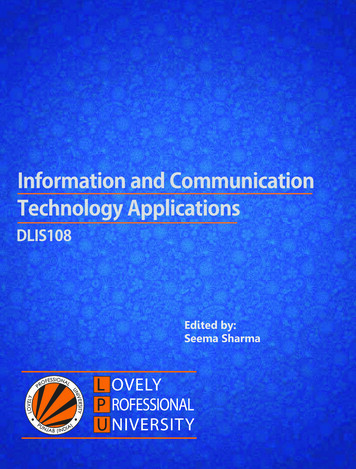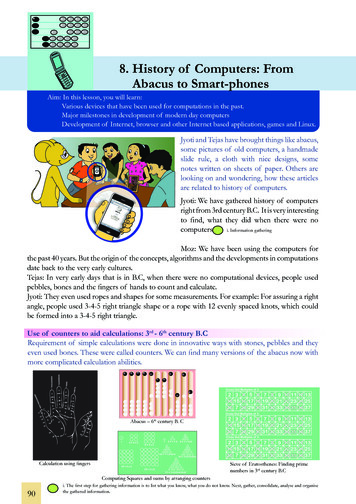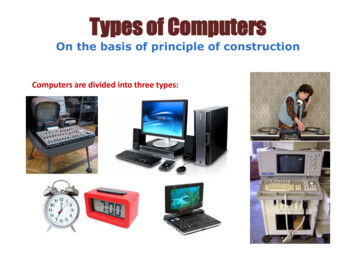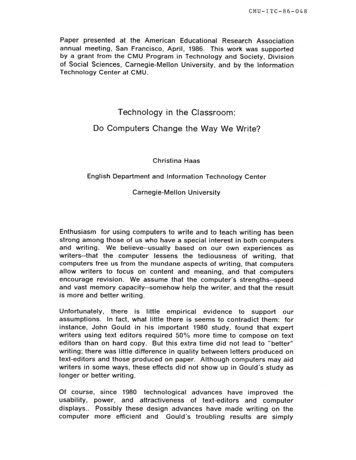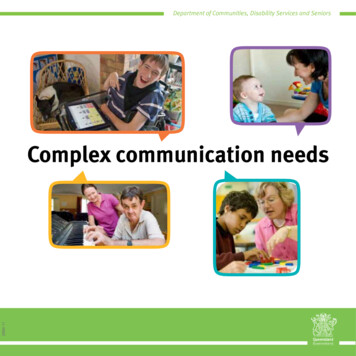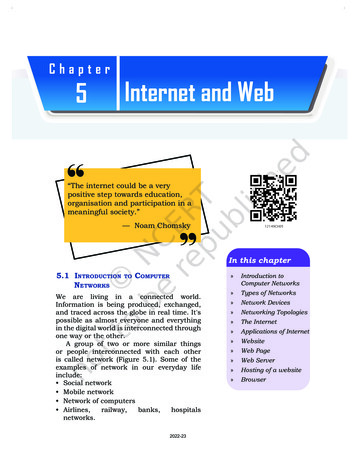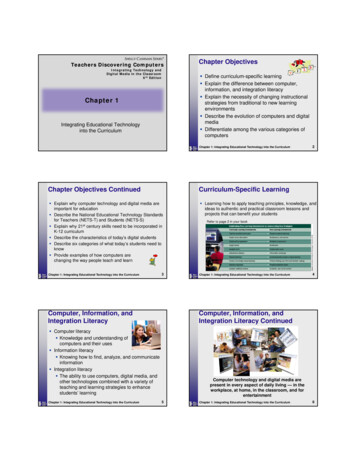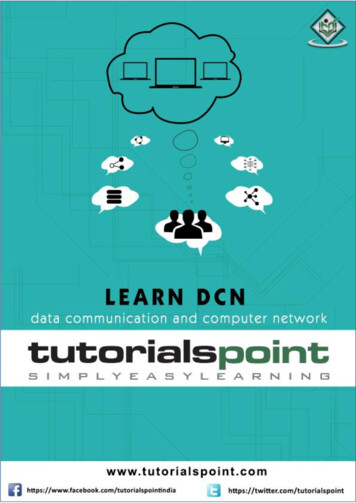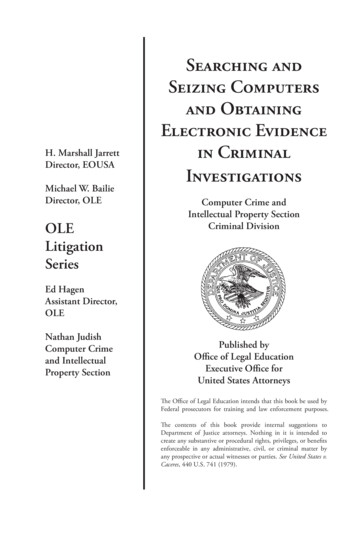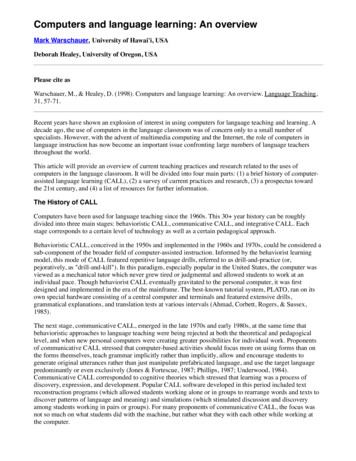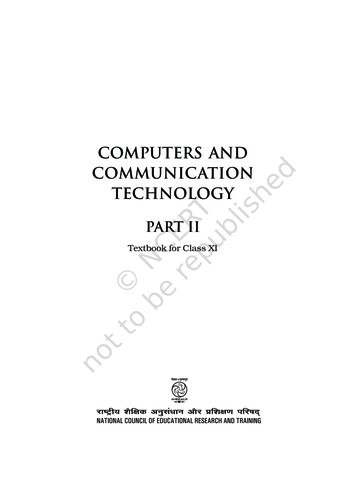
Transcription
Computers andCommunicationTechnologyPart IITextbook for Class XI
ISBN- 978-93-5007-543-3First EditionApril 2010 Vaisakha 1932ALL RIGHTS RESERVEDq No part of this publication may be reproduced, stored in a retrieval system orPD 5T BS National Council of EducationalResearch and Training, 2010transmitted, in any form or by any means, electronic, mechanical, photocopying,recording or otherwise without the prior permission of the publisher.q This book is sold subject to the condition that it shall not, by way of trade, be lent, re-sold, hired out or otherwise disposed of without the publisher’s consent, in any formof binding or cover other than that in which it is published.q The correct price of this publication is the price printed on this page, Any revisedprice indicated by a rubber stamp or by a sticker or by any other means is incorrectand should be unacceptable.OFFICES OF THE PUBLICATIONDEPARTMENT, NCERTRs. 00.00NCERT CampusSri Aurobindo MargNew Delhi 110 016Phone : 011-26562708108, 100 Feet RoadHosdakere Halli ExtensionBanashankari III StageBangalore 560 085Phone : 080-26725740Navjivan Trust BuildingP.O.NavjivanAhmedabad 380 014Phone : 079-27541446CWC CampusOpp. Dhankal Bus StopPanihatiKolkata 700 114Phone : 033-25530454CWC ComplexMaligaonGuwahati 781 021Phone : 0361-2674869Publication TeamPrinted on 80 GSM paper with NCERTwatermarkPublished at the Publication Departmentby the Secretary, National Council ofEducational Research and Training,Sri Aurobindo Marg, New Delhi 110 016and printed at .Head, PublicationDepartment: Neerja ShuklaChief ProductionOfficer: Shiv KumarChief Editor: Shveta UppalChief BusinessManager: Gautam GangulyAssistant Editor: Bijnan SutarProduction Assistant : Mukesh GaurCoverBanyan TreeIllustrationsAshwani Tyagi
FOREWORDThe National Curriculum Framework (NCF) 2005 recommends thatchildren’s life at school must be linked to their life outside the school.This principle marks a departure from the legacy of bookish learning whichcontinues to shape our system and causes a gap between the school,home and community. The syllabi and textbooks developed on the basis ofNCF signify an attempt to implement this basic idea. They also attempt todiscourage rote learning and the maintenance of sharp boundaries betweendifferent subject areas. We hope these measures will take us significantlyfurther in the direction of a child-centred system of education outlined inthe National Policy on Education (1986).The success of this effort depends on the steps that school principalsand teachers will take to encourage children to reflect on their own learningand to pursue imaginative activities and questions. We must recognisethat, given space, time and freedom, children generate new knowledge byengaging with the information passed on to them by adults. Treating theprescribed textbook as the sole basis of examination is one of the keyreasons why other resources and sites of learning are ignored. Inculcatingcreativity and initiative is possible if we perceive and treat children asparticipants in learning, not as receivers of a fixed body of knowledge.These aims imply considerable change in school routines and mode offunctioning. Flexibility in the daily time-table is as necessary as rigour inimplementing the annual calendar so that the required numbers ofteaching days are actually devoted to teaching.NCF–2005 envisages an increase in the optional number of subjectsavailable for students of Classes XI and XII. This textbook marks an attemptin this direction. Its subject matter concerns how we work with computers,rather than about how computers works. It is expected that this textbookwill be used with the help of methods of teaching which might enhancethe flexible and participatory nature of new communication technology.NCERT appreciate the hard work done by the Textbook DevelopmentCommittee and its Chief Advisor, Professor M.M. Pant, Former Pro-Vice Chancellor,
Indira Gandhi National Open University, New Delhi. We are indebted to theinstitutions and organisations which have generously permitted us to draw upontheir resources, material and personnel. We are especially grateful to the membersof the National Monitoring Committee, appointed by the Department of Secondaryand Higher Education, Ministry of Human Resource Development under theChairpersonship of Professor Mrinal Miri and Professor G.P. Deshpande, for theirvaluable time and contribution.As an organisation committed to systemic reform and continuousimprovement in the quality of its products, NCERT welcomes commentsand suggestions which will enable us to undertake further revision andrefinement.New DelhiMay 2008(iv)DirectorNational Council of EducationalResearch and Training
PREFACEComputers have become a way of life in the present day world. That everyoneshould be educated about the implications of this technology is the needof the hour. Till now NCERT has not proposed a course or brought out atextbook in this area. The course outlined for this textbook is an attemptto design a generally friendly course that would not only be contemporarybut also leave sufficient scope for expansion into unknown realms ofcomputer activity that may emerge in future.The National Curriculum Framework 2005 recommends that theoreticalcomponent of Higher Secondary stage should emphasise on problem solvingmethods and that the awareness of historical development of key conceptsbe judiciously integrated into the content of a subject. It also recommendsthat given the pervasive impact of Computer and CommunicationTechnologies (CCT), a course related to this should address thisinfrastructure challenge seriously and explore viable and innovativealternatives with regard to hardware, software and connectivitytechnologies appropriate for rural and urban Indian schools.NCF 2005 states that the book should act as an instrument for achievingsocial change in order to reduce the divide based on economic class, gender,caste, religion and region. NCF also speaks about tremendous effectivenessof the computer and computing technology in shaping modern societywhich has created the need for an educated public that can utilise suchtechnology most effectively for the betterment of society and humankind.This book is aligned to these broad guidelines of NCF.Presumably, this would be a coveted book for “everybody”, irrespectiveof any particular stream of higher secondary stage, for it deals with thereal challenges that the discipline is trying to solve. It emphasisesdevelopment of problem-solving and, equally important, problemformulating skills. It reduces the importance of technology and underscoresthe need for learning skills to manipulate the technology. It focuses onsome of the real problems that come up with the expansion of the technology– security, piracy and digital identity. Above all, the course focuses as
much on the excitements as on the limitations of the new informationtechnology. Effective integration of information and communicationtechnologies into all curricula assists students in developing the abilitiesto use, manage, and understand the technologies.The National Knowledge Commission refers to preparing a work-forceadequately skilled and oriented to actively participate in the emergingKnowledge Economy. This book would be a major contributor towardsdeveloping the skills sets required for all school leavers.This part of Class XI textbook contains six chapters under three themes/units, viz., Web Publishing Technology; Teamwork and Web BasedCollaboration Tools and Emerging Technologies. The book has beenconscientiously designed and is the result of the renewed efforts of theTextbook Development Team comprising of school teachers, subject experts,academicians and technical experts from government, non-government andprivate institutions/organisations. Some of the members worked at theadvisory level while others worked towards the actual developmental activity.It is hoped that the students will appreciate the beauty and logic ofcomputers and communication technology. It has truly been a team work.The course is not biased towards any stream; it can be opted as anelective subject with any other combination, be it science, commerce, artsor humanities. The students may or may not continue to study aboutcomputers beyond the higher secondary stage but it seems they will findthe inherent logic behind CCT useful in any other branch they may like topursue, be it administration, languages, social sciences, environment,engineering, technology, sciences, mathematics, medicine or any otherbranch of knowledge. In order to encourage learning through solving reallife problem in collaborative environment, a full chapter is devoted to“Project based Learning”. Also, chapter on “CCT Projects in Local Context”will provide insight about effective uses of CCT in improving quality of lifeof a common man, be a fisherman, a farmer, a teacher, or a businessman,a Government employee or anybody in their day today needs. Also with ahope that the child should be able to visualise that the journey fromAbacus to PC has not come to an end, rather it is evolving continuouslyand efforts are going on bring further advancements in technology and itstools, a chapter on “Emerging Trends in CCT” has been introduced. Forthose who pursue computers beyond this stage the content of the bookwill certainly provide a sound base.In this book we have tried to bring in a conceptual coherence. Thepedagogy and the use of easily understandable language are at the core ofour effort without sacrificing the rigour of the subject. The nature of thesubject of CCT is such that a certain minimum use of mathematics is amust. We have tried to develop the mathematical formulations in a simpleand logical fashion as far as possible.(vi)This book has some features which, we earnestly hope will enhance itsusefulness for the students. Each chapter is provided with objectives in
the beginning and a summary at its end for a quick overview of the contentsof the chapter. There are some questions which require critical thinkingwhich would make a student think about real-time application of CCT.Further, a large number of solved examples are included in the text inorder to clarify the concepts and/or to illustrate the application of theseconcepts in everyday real-life situations. Some Practical activities/Casestudies have been included which provokes students for deep thinking.Some of these are from real-life situations. Students are urged to solvethese and in doing so, they may find them very educative. Some itemsinside boxes are introduced in many chapters either for this purpose or tohighlight some special features of the contents requiring additionalattention of the learners. Some information has been provided in shadedbox which is meant for supplementary reading and not for evaluation.Glossary of terms and concepts is given towards the end which will act asa ready reckoner.Completing this book has only been possible because of the spontaneousand continuous support of many people. We express our gratitude to theDirector, NCERT, for entrusting us with the task of preparing this textbookas a part of national effort for improving general/school education. TheHead, Department of Computer Education and Technological Aids, NCERT,was always willing to help us in our endeavour in every possible way.The draft got excellent academic inputs from teachers, students andexperts who sincerely suggested improvement during the development ofthis book. We are thankful to all those who conveyed these inputs toNCER T. We are also thankful to the members of the Review Workshoporganised to discuss and refine the first draft.We welcome suggestions and comments from our valued users, especiallystudents and teachers. We wish our young readers a happy journey to theexciting realm of CCT.M. M. PantChief AdvisorTextbook Development Committee(vii)
TEXTBOOK DEVELOPMENT COMMITTEECHIEF ADVISORM.M. Pant, Professor, Former Pro-Vice Chancellor, Indira Gandhi National OpenUniversity (IGNOU), New DelhiMEMBERSArpita Burman, Scientist ‘D’, National Information Centre (NIC), Department ofInformation Technology, Ministry of Communication and Information Technology,New DelhiBasav Roychoudhury, Lecturer, Rajiv Gandhi Indian Institute of Management (RGIIM),Shillong (Meghalaya)C. Gurumurthy, Director (Academic), Central Board of Secondary Education, ‘ShikshaKendra’, New DelhiChandita Mukherjee, Director, Comet Media Foundation, MumbaiDeepak Shudhalwar, Lecturer, PSSCIVE, BhopalDivya Jyoti, PGT, Computer Science, SLS DAV Public School, Mausam Vihar, DelhiGurpreet Kaur, Head, Department of Computer Science, G. D. Goenka Public School,Vasant Kunj, New DelhiH.N.S. Rao, Deputy Commissioner (Academic) (Retired), Navodaya Vidyalaya Samiti (NVS),New DelhiRajendra Tripathi, Facilitator - People Development, Azim Premji Foundation, BangaloreM.P.S. Bhatia, Assistant Professor, Netaji Subhas Institute of Technology, New DelhiManish Kumar, PGT, Rajkiya Pratibha Vikas Vidyalaya, Raj Nivas Marg, DelhiMukesh Kumar, Head, Department of Computer Science, Delhi Public School,R.K. Puram, New DelhiPrakash Khanale, Vice Principal, DEM College of Parbhani, Maharashtra
Rajni Jindal, Assistant Professor, Department of Computer Engineering,Delhi College of Engineering, DelhiSushila Madan, Director-IT, Vivekanand Institute of Professional Studies,Shivaji Marg, New DelhiV.P. Chahal, PGT Computer Science, Jawahar Navodaya Vidyalaya,Mungeshpur, DelhiUtpal Mallik, Professor (Retired), NCERT, New DelhiCOORDINATORAsha Jindal, Reader, DCETA, NCERT, New DelhiTEAM MEMBERRajaram S. Sharma, Professor and Head, DCETA, NCERT, New Delhi(x)
ACKNOWLEDGEMENTThe National Council of Educational Research and Training (NCERT)gratefully acknowledges the valuable contributions of individuals andorganisations involved in the development of the Part II of the textbook‘Computers and Communication Technology (CCT)’ for Class XI.The Council also thanks Professor Vasudha Kamath, Joint Director, CIET,Professor Kamlesh Mittal and Smt. Pushp Lata Verma for their supportand help at various stages.The Council also acknowledges the contributions of the supportingstaff of Department of Computer Education and Technological Aids(DCETA), Moqaddas Azam and Narender Kumar Verma DTP Operator inshaping this book. The efforts of the Publication Department, NCERT arealso duly acknowledged.The Council is grateful to the websites and authors who have offeredimages, illustrations and content in the public domain. Specific creditsare given at appropriate places in the textbook.The Council gratefully acknowledges continuous help and support fromProfessor M. M. Pant, Chief Advisor, Textbook Development Committee inconceiving and developing the textbook.
CONSTITUTION OF INDIAPart III (Articles 12 – 35)(Subject to certain conditions, some exceptionsand reasonable restrictions)guarantees theseFundamental RightsRight to Equality before law and equal protection of laws; irrespective of religion, race, caste, sex or place of birth; of opportunity in public employment; by abolition of untouchability and titles.Right to Freedom of expression, assembly, association, movement, residence and profession; of certain protections in respect of conviction for offences; of protection of life and personal liberty; of free and compulsory education for children between the age of six and fourteen years; of protection against arrest and detention in certain cases.Right against Exploitation for prohibition of traffic in human beings and forced labour; for prohibition of employment of children in hazardous jobs.Right to Freedom of Religion freedom of conscience and free profession, practice and propagation of religion; freedom to manage religious affairs; freedom as to payment of taxes for promotion of any particular religion; freedom as to attendance at religious instruction or religious worship in educationalinstitutions wholly maintained by the State.Cultural and Educational Rights for protection of interests of minorities to conserve their language, script and culture; for minorities to establish and administer educational institutions of their choice.Right to Constitutional Remedies by issuance of directions or orders or writs by the Supreme Court and HighCourts for enforcement of these Fundamental Rights.
CONTENTSFOREWORDiiiPREFACEvUNIT IVWEB PUBLISHING TECHNOLOGIESChapter 9:Chapter 10 :229–322Web Page Designing Using HTML231Client-Side Scripting Using JavaScript274UNIT VTEAMWORK AND WEB BASED COLLABORATION TOOLS323–356Chapter 11 :Project Based Learning325Chapter 12 :CCT Projects in Local Context349UNIT VIEMERGING TECHNOLOGIES357–385Chapter 13 :Emerging Trends in CCT359Chapter 14 :Computer Controlled Devices376GLOSSARY386–395INDEX396–401
CONTENTSOFPART-IUNIT IWELCOME TO THE WORLDOFCCTChapter 1 : Experiencing the World of CCTChapter 2 : Components of CCT1–68315UNIT IIWORKPLACE PRODUCTIVITY TOOLS69–141Chapter 3 : Word Processing Tool71Chapter 4 : Electronic Spreadsheet96Chapter 5 : Electronic Presentation Tool123UNIT IIICOMMUNICATION CONCEPTSANDSKILLS142–205Chapter 6 : Convergence of CCT144Chapter 7 : The Internet163Chapter 8 : Soft Skills for Effective Communication185GLOSSARY206–217INDEX218–228
computers and communication technology. It has truly been a team work. The course is not biased towards any stream; it can be opted as an elective subject with any other combination, be it science, commerce, arts or humanities. The students may or may not continue to study about computers beyond the higher secondary stage but it seems they will .
